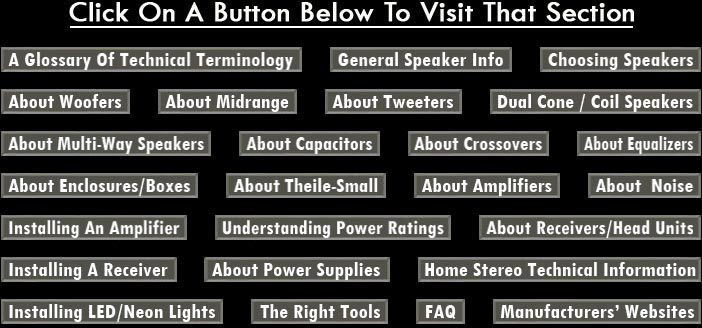


SACD (Super Audio Compact Disc)
SACD is one of two main emerging new standards for high-resolution audio on compact discs. The other is DVD-Audio. It was developed by Sony and is based on a licensed technology called Direct Stream Digital, which was developed by Sony and Phillips and is theoretically capable of sample rates up to 2.8 MHz. The SACD format allows for playback of multi-channel audio and a bandwidth of 100 kHz at over 120 dB dynamic range while retaining compatibility with existing compact disc technology. There are several subformats in the works (single layer, dual layer, etc.) that are optimized for different tasks, but Sony claims that all SACD discs have fully uncompromised audio quality. That is, no data compression, and no computer generated surround mixes from stereo data or vice versa. The potential success of this format in the mainstream is currently under scrutiny amidst other developments such as DVD Audio, but there are a number of titles available on the Sony label with promised support from other record labels.
Satellite Radio
Digital radio transmission system that utilizes satellites in space to broadcast directly to ground based and mobile receivers. Two existing networks, Sirius and XM offer hundreds of channels of diverse offerings for a subscription fee. Separate standards govern the reception of each, so a choice must be made prior to aquiring the system.
Scan tuning
In FM receivers, Preset Scan automatically plays a brief sample of what's on each of the preset stations. Station Scan samples each strong station regardless of whether it has been preset. Seek tuning moves to the next strong station and stops there a the "Seek" button must be manually initiated again to repeat the process.
Screw Type (terminal)
The most secure method of interconnecting the wire from the amplifier to a speaker. In its best realization, the terminal has a post with a hole drilled through it at the base, through which the incoming conductor is placed. A cap is then screwed down from the top of the terminal, compressing the wire below.
Sd (a Theile Small parameter)
Effective piston radiating area of a subwoofer driver in square meters.
Sealed (enclosure)
Sometimes known as an Acoustic suspension type, the sealed enclosure is a simple design in which each woofer is mounted in a sealed, airtight box or compartment with a specific internal volume for precisely the woofer being used. The air contained within the box or compartment then acts as a spring that allows more control over the speaker's behavior. Great care must be taken in design, as too small a box will sound "boomy," while too large a box may have hardly any bass at all. This should be remembered when replacing a woofer in such an enclosure. Best results can be expected when using woofers with a QTS between .30 to .90. These speakers offer good control, low Distortion and high power handling.
Second-Order
The frequency attenuation that occurs at a rate of 12 dB per octave.
Selectivity
Tuner specification which defines the tuner's ability to reject adjacent station interference.
Sensitivity (Efficiency)
The rating of a loudspeaker that indicates the level of a sound intensity that the speaker produces (in dB) at a distance of one meter when it receives one watt of input power.The Efficiency or Sensitivity rating indicates how effectively a speaker converts electrical power from the amplifier into sound pressure. This is frequently related to larger magnet sizes, larger voice coil diameters, and more compliant suspensions. Optimized enclosures are essential in achieving maximum sensitivity, overall. The higher the Decibel number, the more efficient the speaker and the louder it will play with the same input power. While usually more expensive, an efficient speaker helps maximize the potential of the available power.
Also - The relative sensitivity to the reception of RF signals in a tuner measured in dBf. The lower the number the better. Normal is now 10 to 14 dBf.
Separates or Matched Components
A typical separates system includes a separate woofer, tweeter, and external Crossover, all of which are designed to work smoothly with one another. Generally, these components are made of better materials than two-and three-way Drivers. Separate woofers may be easier to mount in tight places because tweeter protrusion is not a factor. Separate tweeters allow positioning for optimum imaging. Given adequate power, separates can deliver excellent dynamics and detail. Separates are often a superior speaker design choice for many installations.
Short Circuit
The condition that occurs when a circuit path is created between the positive and negative poles of a battery, power supply, or circuit. A short circuit will bypass any resistance such as working componenets in a circuit, and cause it not to operate.
Shuffle Play
A feature which employs random selection from available tracks.
Sibilance
High frequency complex sounds in speech, such as "S", "F" & "T".
Signal processors
Electronic devices which alter sound either to achieve a particular effect or to solve a problem with that sound (e.g. delays, compressors, reverbs, noise gates, equalizers).
Signal To Noise Ratio
A measurement of noise level in a device compared to the level of the signal. Higher numbers signify a greater difference, which is better. In technical terms, it is the ratio, expressed in dB, of signal power at a reference point in a circuit, to the noise information that would exist if the signal were removed (the noise floor). The maximum signal to noise ratio (equivalent to dynamic range) of a given piece of equipment can be seen as a measure of functional fidelity. This ratio is how much absolute noise it produces, compared to the highest signal voltage it can pass without distortion.
Silk Dome (tweeters)
Dome tweeters in which the dome is composed of a treated soft silk like material. This is a design that is much less susceptible to mechanical deformation, and yet yields a fairly smooth response over the extent of its range.
Slew Rate
Slew rate measures the ability of a piece of audio equipment to accurately reproduce fast changes in amplitude. Measured in volts per microsecond, this spec is most commonly associated with amplifiers, but can bet applied to most types of equipment. In amplifiers, a low slew rate softens the definition of a signal, blurring transients and sounding "mushy." Slew rate is most critical in high frequencies reproduction where rapid changes in amplitude are most pronounced. An amplifier with a higher slew rate is often subjectively rated as tighter and more dynamic.
Slope
The rate of change that a frequency response curve displays, normally stated in dB per Octave. Among other things, Slope can relate to Roll Off rates in Crossover action, low-end roll off and roll on rates and other forms of increasing or decreasing response.
Sound
A type of physical kinetic energy called acoustical energy that falls within the portion of the spectrum to which humans are sensitive.
Sound Discriminator
A device designed to evaluate, and discriminate between the sounds that may be heard within the interior of a vehicle, and then trigger the security system should the sound fit within the parameters of what the sensor is designed to react.
Sound Field
The totality of the sound presented by the audio system. This includes the sound as it was recorded, mixed, transported, reproduced, and finally heard by the listener.
Sound Shaping
A sophisticated cicuit that defines the parameters of the sonic experience with a blending of directional and tonal adjustments to acheive both realistic and synthetic effects.
Soundstage
The position (front/back and high/low) that music or sound appears to be originating from, as well as the apparent depth of the stage. A car with speakers only in the front will likely have a forward soundstage, but may not have enough rear fill to make the music seem live. A car with both front and rear speakers may have anything from a forward to a rear soundstage, with an accompanying fill from the softer drivers depending on the relative power levels and the frequencies reproduced. The high/low position of the soundstage is generally only obvious in a car with a distinctly forward soundstage. The music may seem to be originating in the footwells, the dash, or out on the hood, depending on the car's design.
Sound Power
The total amount of acoustical energy produced by a sound source and measured in Joules per second. The degree to which this measurement is constant( or linear)with respect to frequency, is an index of the overall fidelity of the system.
Sound Pressure Level (SPL)
An acoustic measurement of sound energy. 1 dB SPL is the smallest increment in sound level to which the average human is sensitive. Theoretically, 0 dB SPL is the threshold of human hearing while approximately 120 dB is the threshold of pain.
Soundstage
Individual vocal and instrumental "images" make up your stereo system's soundstage. The degree to which particular sounds can be localized in space is an index to the quality of the imaging. The better the soundstage, the greater the sense of its definite width, depth and height. (See also Imaging above)
Sound Waves
Fluctuating waves of barometric pressure that travel through a physical medium such as air. An acoustic wave consists of a traveling vibration of alternate compressions and rarefactions, whereby sound is transmitted through air or other media.
Source Impedance
A parameter of an audio component referring to the output impedance. A low output impedence .5 to 4 ohms, is preferred for automotive applications.
Spider
The rear suspension element on the cone of a loudspeaker. All the moving parts of the speaker are suspended by the spider in the rear and the Surround in the front. The spider is so named because of its resemblance to an arachnid, especially in the way in which flexion is obtained in the design of the concentric pleats that allow back and forth motion. (SeeSurround)
SPL (see Sound Pressure Level above)
Stamped (Basket)
The frame of a loudspeaker which has been stamp pressed to achieve its shape. It is used as a base to mount all the other elements of the driver. With a frame of adequate thickness and strength, this arrangement should perform well for the life of the speaker. (See Cast Frame,)
Standing Wave
A phenomenon where a sound is reflected between two parallel surfaces, such that certain sounds are made more intense and others diminished in given parts of a listening environment. Technically they are created by room modes, which are modes of vibration of air in the room. The sound waves interfere with one another to produce a series of places where the sound pressure level (SPL) at some frequencies is high, and another series of places where they are low. The places are sometimes called peaks and nodes. A standing wave exists in a room where a frequency is such that the distance between any two surfaces is equal to one half of its wavelength. For a given distance there will be many frequencies that will generate standing waves, each a multiple of the fundamental frequency whose wavelength is related to the dimension in question. Standing waves are always detrimental to the acoustics of a room, but can be avoided by careful room design, or minimized by absorbing certain frequencies where they build up, which is usually along walls or in corners.
Streaming
A technique for transferring data such that it can be processed as a steady and continuous stream. Streaming technologies are often used on the Internet because many users do not have fast enough access to download large multimedia files quickly, so the client browser or plug-in can start displaying the data before the entire file has been transmitted.
Stroke
The distance that the speaker cone or voice coil can travel in both directions.
Studio Monitors
Speakers used in recording studios for playback and mixing of source recordings. While these are commonly thought of as extremely highly developed speakers, it is often true that some home oriented speakers may offer better performance. The term 'monitor' has become not so much a technical description, as an advertising ploy to sell expensive speakers. View such claims with skepticism. Favor a more analytical approach to an individual speaker's performance.
Subwoofer (see Woofer)
Subwoofer Preamp Outputs
Individual number of RCA outputs that are coupled with a built-in low-pass crossover for connection to a dedicated subwoofer amplifier.
Surface (mounting)
A method of mounting speakers in which the external parts of the upper speaker protrude above the surface on which it is mounted.
Surround
The surround is the flexible ring around the edge of the speaker cone. In conjunction with the inner suspension element called a Spider, it determines the overall impedance of the speaker. Pleated, treated cloth surrounds are usually stiffer and less compliant than their foam and rubber rolled edge cousins. A flexible suspension system in the speaker usually indicates greater efficiency. For some units, it is desirable to have suspensions that are pliable enough to let the woofer cone travel freely in and out. A technical specification for this characteristic in more expensive speakers, is XMS. The further the cone can travel and the more compliant it is, the stronger the bass can be in enclosures that take advantage of it. However, certain types of very good enclosures require a more limited, stiffer cone movement to develop their more controlled and High Fidelity response. Surrounds are usually made of cloth, foam or rubber. Rubber tends to last longest.
Super Tweeter
A Driver constructed to reproduce the highest possible frequencies from roughly 13 kHz to 25 kHz. While most standard Tweeters can do an excellent job right up to 16 or 20 kHz, these units deliver the most extreme parts of the upper range for those fortunate (or not) few who can actually hear them.
Supraaural
Term used in reference to headphones. Supraaural phones rest on the ear, rather than enclosing the ear. Supraaural phones typically are lightweight, and because they do not seal around the ear, tend to not provide good isolation, but permit the listener a higher degree of awareness of external sounds.
Sweet Spot
The so-called "best" listening position in which the sound field is overlapped by the most direct radiations from all the speakers, and imaging is most convincingly achieved.















